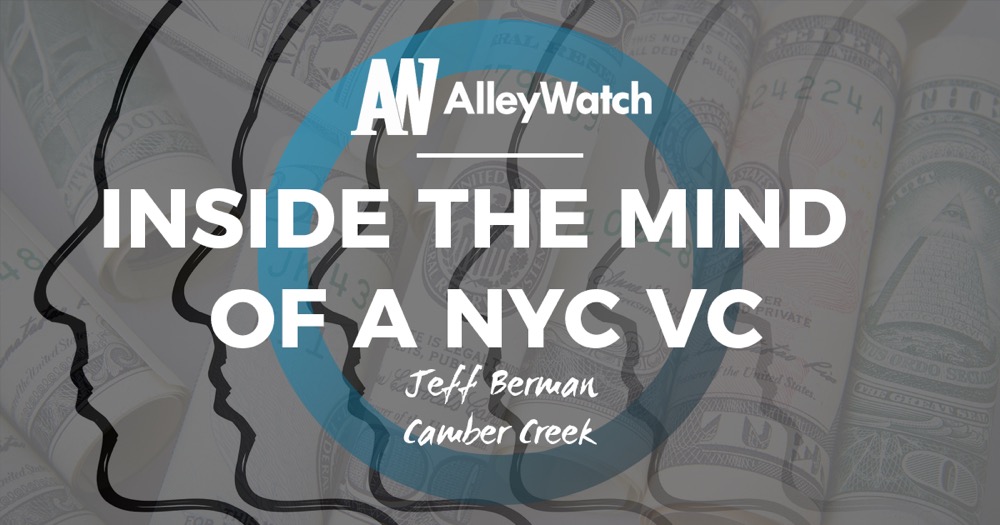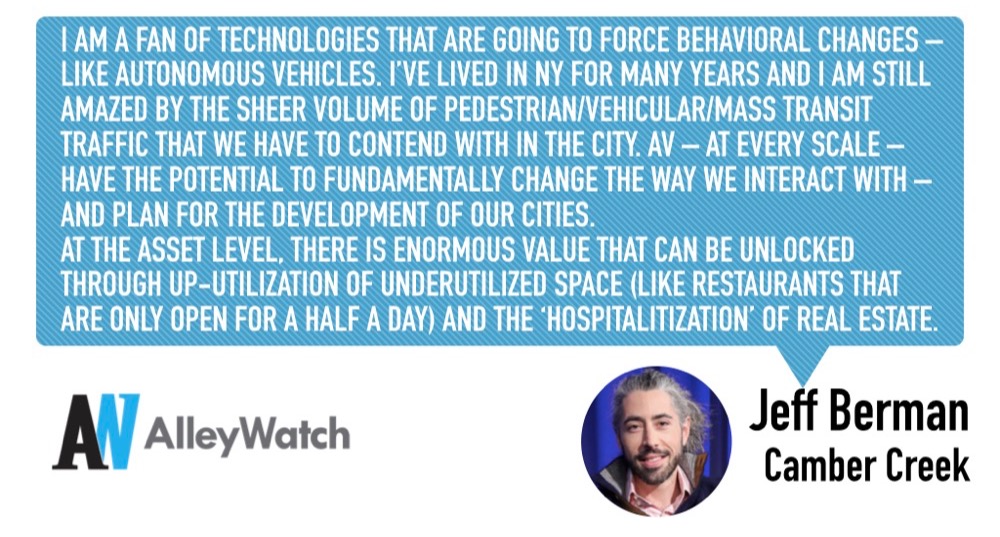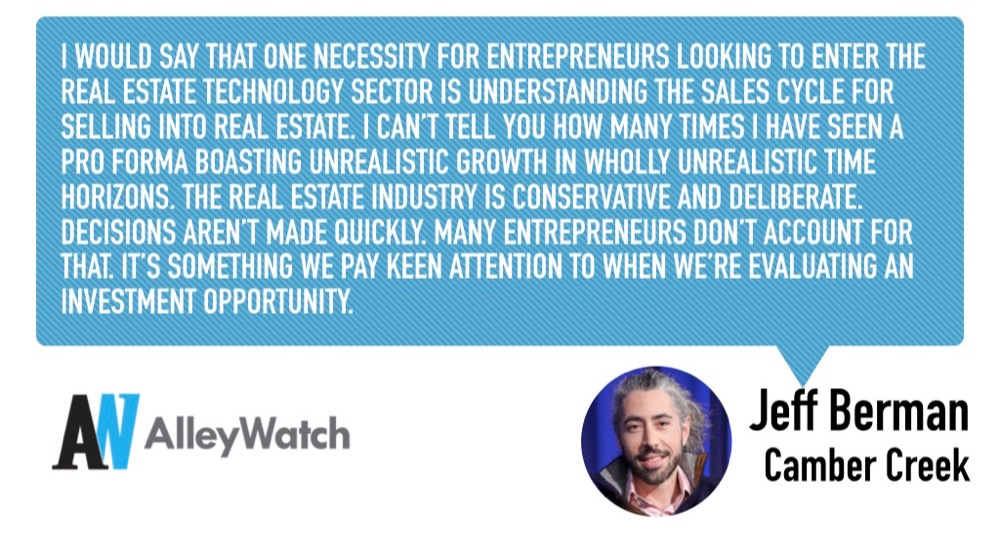Welcome back to Inside the Mind of an NYC VC, a highly acclaimed series at AlleyWatch in which we speak with New York City-based Venture Capitalists. In the hot seat this time is Jeffrey Berman, General Partner at Camber Creek, real estate technology-focused early-stage venture fund. Currently investing out of its second fund, which just closed in June at $30M, Camber Creek has made over 25 investments in companies such as ParkiFi, Latch, Bowery, Measurabl, 42Floors, and VTS.
Jeffrey joined us to discuss the evolution of Camber Creek from a family office investment vehicle to a venture fund, the value-add that Camber Creek’s unique LP base offers its portfolio companies, the future of real estate tech investing, “hospitalitization” of the real estate industry, tips for entrepreneurs seeking funding, and much, much more.
Please tell us a little bit about your background and how you started in venture.
I’ve been working in the real estate industry in various capacities for almost twenty years. As an executive, I saw firsthand some of the challenges that could be solved by technology but weren’t being addressed. So when I had the opportunity to join Casey (Casey Berman) at Camber Creek to help support and grow the companies that were trying to do just that I jumped at the opportunity.
I currently run Camber Creek’s New York office and have been here in the city on and off since graduating from New York University’s Stern School of Business in 2001.
It’s an exciting time at Camber Creek. You just announced a brand new fund. Please tell us about that.
Yes, we just announced the close of our second fund – a $30M vehicle to continue our mission to invest in technology companies that provide novel solutions to the real estate industry. We focus exclusively on the real estate sector, but within that sphere, we’ll look at any company that is building technology that addresses pain points experienced by various stakeholders in the real estate space, including developers, operators, and service providers.
How does investing as a fund differ than the previous family office investing you did? How are your role, responsibilities, and outlook different?
The Camber Creek fund structure provides more leverage through the LP network and has a sector-specific mandate, real estate technology. The fund also has a more traditional standard for time horizon and investment period. Additionally, the Camber Creek platform provides a more compelling value proposition for founders; we are able to create more value for them in a variety of ways. This allows us to win the best deals and take a more meaningful ownership stake as we help these companies succeed.
 What was the fundraising process like as venture capitalist to pitch LPs? What about your fund was appealing to them?
What was the fundraising process like as venture capitalist to pitch LPs? What about your fund was appealing to them?
It was both humbling and heartening. Humbling, in the sense that we were asking people for money and – let’s face it – that’s not an easy thing to do. But at the same time, it was heartening because our message was well received and we ended up being oversubscribed and raising capital quickly. The majority of our LPs come from the real estate industry so I think the appeal stems from two points unique to Camber Creek. First, our LP’s had an innate understanding of the pain points in their businesses but didn’t have the systems and processes in place to discover, evaluate and invest in the technology solutions available. We solve that problem for them. Second, they appreciated what we were building and the investor group we were assembling. In aggregate, Camber Creek’s investors own and manage more than 150 million square feet of commercial real estate and over 150 thousand multifamily units distributed across more than 2000 properties nationwide and represent a broad spectrum of real estate industry expertise. Our LP’s appreciated that our network was going to give us the ability to bring portfolio companies a built-in customer base. Additionally, becoming a member of the group, where the whole is truly greater than the sum of its parts, was attractive in and of itself.
What can entrepreneurs expect with this new fund?
Entrepreneurs can expect us to evaluate investment opportunities in a thoughtful manner with a systematic approach. What I mean by that is our investment mandate is clear – we invest in enterprise technologies that are purpose-built for the real estate industry primarily focusing on those that have application to the collective portfolio of assets owned and operated by our LPs. This approach allows us to de-risk investments and create outsized returns while simultaneously creating value for our LP’s real estate businesses. We’ll continue to make early-stage investments, primarily around Seed, Series A and Series B.
How has real estate tech in NYC evolved since you started? Any observations – what do we do well and what do we need to improve on? Where are we as an ecosystem going forward from your vantage point?
There was a dynamic shift in the way the real estate community in NYC looks and views real estate technology. It was only a few years ago that landlords, developers, brokers – the stakeholders in the space – didn’t embrace the notion that tech could be deployed in their businesses to positive effect…because they didn’t have to. The market woke up and we’re starting to see that stakeholder group embrace CREtech in a vigorous manner because tech (as a generalization/catch-all) is no longer a “nice to have” but rapidly becoming a “need to have”.
As far as what NYC does well: I’m biased because I live here but it’s the real estate capital of the world. The incredible talent in the city is complemented by some of the most valuable real estate in the world. This provides companies with an unparalleled testing ground for their products and services. The city provides all of the ingredients to support a great real estate tech ecosystem and is why NYC is one of the leaders nationally and internationally in the space
When Camber Creek began investing in the space (almost 10 years ago), CREtech was at its embryonic stage – hardly anyone knew what “real estate technology” meant. If you ask me where we are now, I’d say we’re still in the early stages but it is growing with increasing velocity and we are going to continue to see enormous enterprise value being created in the real estate tech space.
What are you excited about in the real estate and PropTech space that has the potential to cause severe disruption?
I am a fan of technologies that are going to force behavioral changes – like autonomous vehicles. I’ve lived in NY for many years and I am still amazed by the sheer volume of pedestrian/vehicular/mass transit traffic that we have to contend with in the city. AV – at every scale – have the potential to fundamentally change the way we interact with – and plan for the development of our cities.
At the asset level, there is enormous value that can be unlocked through up-utilization of underutilized space (like restaurants that are only open for a half a day) and the ‘hospitalitization’ of real estate.
Tell us more about the “hospitalitization” of real estate.
The “hospitalitization” of real estate is being driven by a shift in the way people are procuring and utilizing the spaces they inhabit – whether it be where they work, live, shop, get entertained, etc. In the world of commercial real estate, co-working is a driving force behind the rethinking of how companies/people approach their real estate needs. From a tenant’s perspective, it is no longer necessary to commit to long-term contracts – even for larger companies. And from a landlord’s perspective, the opportunity to differentiate their property from the competition is coming from some of the more enterprising co-working companies saying “let us manage X number of floors of your office building. We’ll break the floors up into a layout conducive for how people are working now and take a percentage of gross.” In that instance, the co-working company is essentially adopting the asset-light hotel operator model. In the multifamily sector, we’re seeing a number of companies literally turning apartment buildings into hotels. One of our portfolio companies – WhyHotel – is taking a novel, tech-forward approach to a problem that almost every developer of multifamily rental property has contended with. They’re operating pop-up hotels in new developments that are in the lease-up process generating revenue in place of vacancy loss all the while providing a tier 1 hotel – caliber experience in an apartment setting.
Tell us about the fund’s thesis and how you partner with your LPs.
Our LP network is comprised of the some of the largest and most successful real estate owner/operators in the country owning and managing in excess of 150M square feet of commercial office/retail + 150K multifamily units across the country. And we’re in direct contact with the decision makers who run these companies. So our investment thesis is pretty straightforward, there are two primary questions we ask when an investment opportunity surfaces: (1) can we use this product, software, or service within our LP’s portfolio matrix, we define portfolio matrix as (a) the buildings our LP’s own (b) the tenants and residents who work and live in our LP’s properties or (c) the vendors who service both and (2) do we believe we can make a venture return on this investment?
I can’t overemphasize the importance of both questions to our decision-making process. Answering the first question in the affirmative gives us confidence that a given portfolio company will have strong growth potential within our LP network. The second question is more nuanced – especially as it relates to the real estate industry. It is really tough to sell into real estate companies. So it’s one thing for a company to assume a j-curve sales growth; it’s quite another to accomplish it in an industry that has traditionally been slow to adopt and adapt to new tech. So when we ask ourselves “do we believe we can make a venture return on this investment” it’s not just relative to the addressable market. Scalability (and all that entails) is factored in as well.
What do you need to see from teams, both qualitatively and quantitatively, in order to invest?
This may sound trivial but given that we’ll be working with the person/people for years to come, the first thing we want to make sure of is that we get along on a personal level. At the end of the day, we’re all human beings and since there’s a high probability that we’ll have to navigate tough waters at some point, having a strong relationship provides a good foundation for being successful in those tough situations. And since we like people that are smart, ambitious and driven, a natural extension of the human angle is – does this person/team have drive? Charisma? Are they excited by and about what they’re doing? The founders that I’m attracted to generate a level of excitement about investing in and with them as much as by what they’re doing. They are able to attract talented people to their vision, including strong early team members, investors, and customers. And on a professional level, the founding team should have domain expertise and unique insight into the problem they’re trying to solve that gives them some edge in their go-to-market strategy.
Our portfolio company, Bowery, is a great example of this. Bowery is a tech-enabled appraisal firm. Appraisals are necessary for most real estate transactions – not terribly exciting but essential. The founders of Bowery come from the appraisal world where processes haven’t really evolved in decades and where a sizeable part of the workflows are still manual. They came with a very specific skill set that gave us confidence that they’d be able to execute on their vision to create a tech-enabled solution. But just as importantly, we liked Noah and John from the moment we met them. They were engaging and had an energy and excitement about them that made us feel like “these guys have what it takes” – and they’re doing a tremendous job. While there have been a number of challenging moments, the fact that we were able to establish a good personal relationship underpinning our business relationship made solving challenges that much easier.
What have you taken away from the companies that you invested in that did not end up making it?
Every situation varies. Fortunately, we’ve had very few losses in the 9+ years we’ve been investing in CREtech but I would say there is one overarching theme that is an imperative: the founding team has to be as strong – if not stronger – than the “great idea” they have. Most companies are only as good as the teams that bring the vision to fruition and when you have people who aren’t quite up to the task, results can be subpar.
Outside of the PropTech investing world – are there any technologies that excite you?
At the risk of sounding one dimensional, not really. I define “excitement” as something that I would dedicate time to understanding. There’s lots of cool “stuff” out there and I’m definitely interested in advances in robotics, biopharma, etc but I am not spending my time learning more about them. There are just too many developments in the proptech (and proptech adjacent) world competing for my attention!
What metrics do entrepreneurs overlook or not place enough emphasis on that are important to consider when you are evaluating investment merit of a business? What metrics are very specific to real estate and PropTech businesses that are important?
I would say that one necessity for entrepreneurs looking to enter the real estate technology sector is understanding the sales cycle for selling into real estate. I can’t tell you how many times I have seen a pro forma boasting unrealistic growth in wholly unrealistic time horizons. The real estate industry is conservative and deliberate. Decisions aren’t made quickly. Many entrepreneurs don’t account for that. It’s something we pay keen attention to when we’re evaluating an investment opportunity.
What can entrepreneurs do to ensure that the funding process is smooth from first meeting to getting to a round close?
Ensure that it’s actually IS a “process” rather than a slapdash attempt at raising money. Companies with entrepreneurs at the helm that are thoughtful during the fundraising stage portend well for the future. Also (and this should be obvious but it’s unfortunately not) being responsive to information requests should be standard operating procedure.
What can entrepreneurs do to ensure that the relationship between the firm and companies is fruitful post investment?
Communication is key. We work closely with our portfolio companies, often side-by-side in trenches, to help them accelerate their success. For example, we make introductions, provide advice and share our market insights. It’s important to set precedent for how often we’ll be communicating with our portfolio companies and vice versa. For one, this ensures neither party is overwhelming the other. Second, it eliminates the risk of nasty surprises from either side.
What are some things that you repeatedly see early-stage companies and founders struggle with?
There are the usual suspects like sticking to budgets, reporting, closing on sales leads, etc. But the one universal struggle I see is around mental exhaustion. There is so much to do when you’re starting up a company: legal, accounting, sales, teambuilding, etc. And it doesn’t end. The challenges just magnify as the company grows – hence the term “growing pains”. One of our jobs as venture capitalists is to provide a sounding board to our portfolio companies to minimize the mental strain.
Quick Hits:
Who do you admire in the startup world and why?
Entrepreneurs in general. It takes a special type of personality and mental grit to buck a conventional 9-5 and start a company. My favorite part of the business is getting to spend time with these types of people.
What’s the last book you read?
I recently re-read The Black Swan by Nassim Taleb.
Are you binge-watching anything right now?
I just finished The Marvelous Mrs Maisel. It was… marvellous.
What’s your favorite outdoor summer activity in NYC?
Spending time with my family and friends (but outdoors and preferably with a good bottle of wine)







